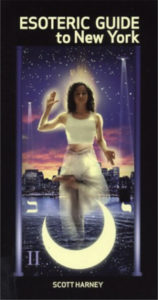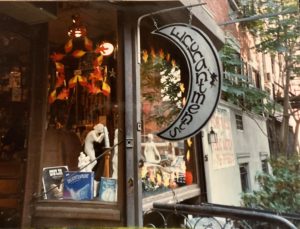An excerpt from “Esoteric Guide to New York”
I was born with a caul on my face and my grandfather was the seventh son of a seventh son. In some cultures, this may have marked me as potentially “gifted,” or even a candidate for shamanic traning.
But growing up in Irish-Catholic Boston, I was always considered a bit “odd” with strange sensibilities. I gravitated toward the mystical and unusual,

Moving to New York City was an obvious choice, the mythical city of possibility and personal freedom, the archetype of all cities. To me, New York was the home of witches, yoga adepts, spiritual gurus, tantric priestesses, and spiritual explorers. New York remains a place where you can reinvent yourself and more importantly, transform yourself. This guide reflects the new Aquarian consciousness, as we move out of the consciousness of the Piscean age. The Age of Aquarius is all about one’s person, and unique spiritual path., while the Piscean Age was all about hierarchy and organized religion. The Aquarian vision is a planetary vision, one that transcens=ds ethnic and religious differences and views the whole world as one big family.
Manhattan is a big rock, granite to be exact, interwoven with billions of quartz crystals. The island itself descends down into the molten core of the Earth. Manhattan is a fiery, passionate spiritual amplifier. What happens in Manhattan happens to the world.
Some say that the island of Manhattan was part of the lost continent of Atlantis, and that there is an ancient “Solar Temple” located in the waters off of lower Manhattan, right near the Statue of Liberty.
Nearly every esoteric group in the 20th century got its start in New York. It is a melting pot of traditions – Wicca, pagan, Santeria, Voodoo, New Thought and many more. The diversity of its spirituality reflects the diversity of the population.
Helena Petrovna Blavatsky made New York City her home in the 1870s and founded the Theosophical Society in what is now Hell’s Kitchen area. She was attracted to the area since New York state was the birthplace of the “Spiritualist” and seance movement. Blavatsky wrote the “Secret Doctrine,” which remains one of the most influential occult books to this day.
Norman Vincent Peale developed the influential “new thought” philosophy from the pulpit of the Marble Collegiate Church of 5th Avenue and 28th Street.
“We tend to think of California as the birthplace of the ‘new age’; however, New York played a very special role as a springboard for alternative spiritual ideas,” occult historian and New Yorker Mitch Horowitz has written. “America has become this laboratory for different religious ideas and a gestation tank where these ideas get remade in very popular ways.”
It was Raymond Buckland who first brought Witchcraft to the United States in 1964, living and opening his first coven in Long Island, NY.

In 1925, horror novelist H.P. Lovecraft moved to New York City.He moved into a first-floor apartment at 169 Clinton Street in Brooklyn Heights, which ushered in a new era, someoccultists believe. Some say malefic, others say liberating.
Even though Brooklyn had not yet been gentrified and there were no “hipsters” living there yet, Lovecraft described his Brooklyn neighborhood as “something unwholesome – something furtive – something vast lying subterrenely (sic) in obnoxious slumber – that was the soul of 169 Clinton Street at the edge of Red Hook.”
So, it was perhaps no coincidence that Herman Slater and Eddie Buczynski opened the Warlock Shop at 300 Henry Street, not far from where Lovecraft used to lay his head. The store became an important hub for the emerging witchcraft and neo-pagan scene in New York. The pair would also make Lovecraft famous in occult circles, when they published the “Necromonicon.”
Slater, a wiccan high priest whose magickal name was Lord Govannon, began experiencing and reading about paranormal activities while recuperating from a serious illness. Slater became known as “horrible Herman” because of the way he yelled at irritable customers. He met Buczynski and the two became lovers and decided to open the store together.
Buczynkski, known as Lord Gwyddion, was a Gardnerian High Priest of the Kentucky Line and from that created the NY Wicca, The New York Coven of Witches the original coven from that movement is still functioning today. The Minoan Brotherhood founded by Eddie then developed the Minoan Sisterhood founded by Lady Rhea and Carol Bulzone (Lady Miw)
Buczynksi grew up in Brooklyn and Queens. Initially, he wanted to become a Catholic priest, but instead moved to Greenwich Village and embraced his gay identity. His friendship with Wiccan Leo Martello introduced him to the Wiccan religion and eventually to Slater. Buczynski is the subject of the fabulous book “Bull of Heaven” by Michael Lloyd.
Lady Rhea, who volunteered and eventually worked there in the 1970s, described the Warlock Shop as having the atmosphere of a “grade b movie in the twilight zone.”
“I originally went to the Warlock Shop to buy a crystal ball and I never left,” she says. “I can still see the store in my mind.”
Rhea says that meeting Buczynski was a major turning point in her life. He became her magickal mentor, and initiator and together they went on to found the Minoan tradition, a witchcraft tradition for gay and lesbian witches.
“Eddie encouraged us to learn other traditions of magic – even Aleister Crowley,” says Rhea, who ended up joining the Ordo Templi Orientis during this time, as well the Rosicrucians. Rhea creates her own eclectic approach to witchcraft to Buczynski.
Rhea recalls how she Buczynski would do rituals in the room above the shop.
“Herman would yell up to us that the store was busy. Eddie would say we are in circle and Herman would shout up – hurry up down and make sure you close the wards!”
She says Buczynski would intentionally sometimes leave the wards open and “all hell would break loose in the store- sometimes books would fly off the shelves.”
The Warlock Shop was financially very lucrative and Slater and Buczynski moved the entire operation to a much bigger space at 35 West 19th Street and called it the Magickal Childe.
As writer and one-time Magickal Childe employee Alan Cabal wrote: “The Magickal Childe was ground zero for the occult explosion in the 1970s.
Wrote Cabal, in his seminal article “The Doom that Came to Chelsea”: “the new store became a one-stop shop for any and all conjuring needs … one could find human skulls, dried bats, mummified cats paws and a wide variety of unusual jewelry … a room in the back of the store served as a temple and a classroom for the various strains of wicca that began to gravitate to the place.
Magickal Childe was most famous for its publication of the famous “Necromonicon” grimoire – hence the Lovecraft connection.
The Necromonicon, also known Book of the Dead or it Arabic “Kitab al-Azif,” was a grimoire appearing in the stories by Lovecraft. The grimoire was – according to Lovecraft – written by the “mad Arab” Abdul al-Hazred and teaches how to summon the “Old Ones.”
he Necromonicon was fictional. However, as Cabal writes, a group of occultists, led by “Simon” (Peter Levenda) and Slater decided to “recreate” the grimoire and pubish it.
“It was a team effort,” Cabal writes. “Herman provided the sponsorship, whil the design and layout were the work of Jim Wasserman of the OTO, a raving cokehead from Jersey named Larry Barnes whose daddy had the production facilities, and a fellow who called himself Khem set Rising (who also designed the sigils). The text itself was Levenda’s creation, a synthesis of Sumerian and later Babylonian myths and texts peppered with names of entities from Lovecraft Cthulhu stories.”
The book was enormously successful and, even though it was “fictional,” some adherents swear that it worked.
Rhea and later Carol Bulzone both worked at the Magickal Childe. Slater was having financial problems – mainly due to the fact that he did not pay taxes – and had decided to sell the store to Rhea and Bulzone in 1982. However, shortly after the two raised the money to purchase the store, he changed his mind.
“We were heartbroken,” Rhea says. “We decided to go out and open our own occult store. We found a great property on East Ninth Street that was only $1000 a month at the time. Rhea and Bulzone ended up leaving Slater and opening Enchantments on 341 East Ninth Street in the East Village.
“At first Herman was upset, but he soon got over it,” She says.
She recounts a humorous story of how Slater was in a dispute with Larry Barnes and did not want to give Barnes the expensive copper plate used to print the leather cover of the Necromonicon.
“So he dropped the plates off at Enchantments to hide them from Larry,” she says. “When Larry found out they were at Enchantments, he came in like a maniac looking for them. We gave them to him – we didn’t want a problem.”
Buczynski eventually died of complications from AIDS in 1989. Slater soon followed and passed away in 1992, also from AIDS. After his death, the Magickal Childe was never the same. It eventually closed in 1999 and is now Sala One Nine, an upscale Spanish restaurant.
Enchantments became ground zero for the Witch and occult community and was a who is who of witches who worked and shopped there. In addition to books, oils, enchanted candles and occult supplies, Enchantments also had classes, rituals, coven meetings and the famous Pagan Grove, run by “Joe and Jezibel” (Jezibel Anat and her partner Joseph Zuchowski – one of our readers).
The NYC occult scene was mostly underground in those days, before social media and mainstream acceptance of witchcraft.
“Today anyone can call themselves a witch – you can even get intitiated into a coven online,” says Zuchowski. “But back when we were working at Enchantments, you really had to know someone who knew someone to get into a coven.”
Many covens were extremely selective and put their prospective members through a vetting process. “It usually revolved around inviting an individual to lunch – and then having the rest of the coven members in the restaurant watching from other tables,” Zuchowski says. “Afterwards, everyone would meet to decide if this person should be accepted in.”
Rhea says that Enchantments was “joyous” when she and Bulone worked there. “We were all happy and everyone loved working there,”she says. “We had a backyard and could have a circle there. I remember doing lots of rituals to Lakshmi there – at one time we have 50 people out in the back chanting to Laskhmi.”
Rhea eventually went her own way to spend more time raising her daughter and sold her half of the business to Bulzone. Lady Rhea went on to open Magickal Realms in the Bronx and was the head of readers for Original Products for many years.
Bulzone also ended up selling the store and moving on. The original Enchantments ended up closing and the location is now the Immigrant wine bar.
The new owner of Enchantments, Stacy Rapp, moved the store down the streets to 424 East Ninth Street. However, the store no longer offers reading and classes. Enchantments has recently moved again, to 165 Avenue B, still in the magical East Village.
Before the pandemic, Lady Rhea and many witches involved in the original Enchantments would hold monthly rituals at the Immigrant. The new wine bar is lovely and retains some of the magickal energy of the store.
Anyway, this just scratches the surface of the occult history of New York.
Comments